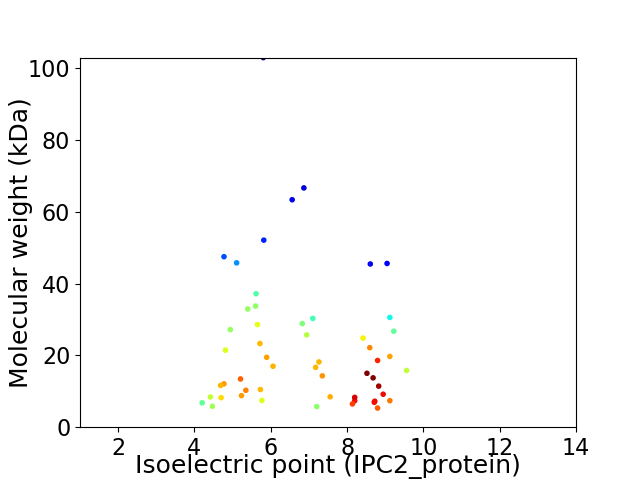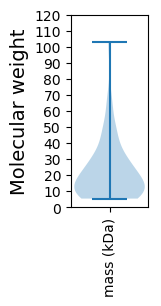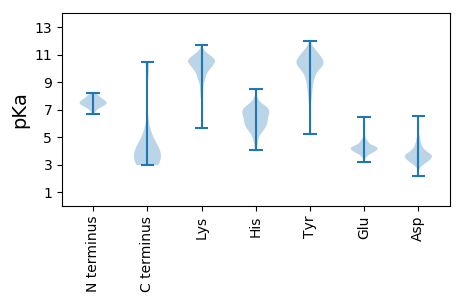
Geobacillus phage GBSV1
Taxonomy: Viruses; Duplodnaviria; Heunggongvirae; Uroviricota; Caudoviricetes; Caudovirales; Myoviridae; Svunavirus; Geobacillus virus GBSV1
Average proteome isoelectric point is 6.86
Get precalculated fractions of proteins

Virtual 2D-PAGE plot for 54 proteins (isoelectric point calculated using IPC2_protein)
Get csv file with sequences according to given criteria:
* You can choose from 21 different methods for calculating isoelectric point
Summary statistics related to proteome-wise predictions



Protein with the lowest isoelectric point:
>tr|Q0H273|Q0H273_9CAUD Putative recombination protein U OS=Geobacillus phage GBSV1 OX=365048 PE=3 SV=2
MM1 pKa = 7.59LVRR4 pKa = 11.84FSLLYY9 pKa = 9.85KK10 pKa = 10.2SGYY13 pKa = 9.27EE14 pKa = 3.8DD15 pKa = 4.64VIEE18 pKa = 4.23QVCLPSEE25 pKa = 4.24VGNIIQTIRR34 pKa = 11.84GSFYY38 pKa = 10.24EE39 pKa = 4.68DD40 pKa = 3.15SPGYY44 pKa = 10.27ISFGDD49 pKa = 3.98EE50 pKa = 3.8NLKK53 pKa = 10.86GYY55 pKa = 9.82IINVQEE61 pKa = 4.09VARR64 pKa = 11.84VKK66 pKa = 10.39MEE68 pKa = 3.72ILEE71 pKa = 4.77GGDD74 pKa = 3.43SS75 pKa = 3.4
MM1 pKa = 7.59LVRR4 pKa = 11.84FSLLYY9 pKa = 9.85KK10 pKa = 10.2SGYY13 pKa = 9.27EE14 pKa = 3.8DD15 pKa = 4.64VIEE18 pKa = 4.23QVCLPSEE25 pKa = 4.24VGNIIQTIRR34 pKa = 11.84GSFYY38 pKa = 10.24EE39 pKa = 4.68DD40 pKa = 3.15SPGYY44 pKa = 10.27ISFGDD49 pKa = 3.98EE50 pKa = 3.8NLKK53 pKa = 10.86GYY55 pKa = 9.82IINVQEE61 pKa = 4.09VARR64 pKa = 11.84VKK66 pKa = 10.39MEE68 pKa = 3.72ILEE71 pKa = 4.77GGDD74 pKa = 3.43SS75 pKa = 3.4
Molecular weight: 8.42 kDa
Isoelectric point according different methods:
Protein with the highest isoelectric point:
>tr|Q0H252|Q0H252_9CAUD HTH_3 OS=Geobacillus phage GBSV1 OX=365048 PE=4 SV=1
MM1 pKa = 7.46RR2 pKa = 11.84QGSQRR7 pKa = 11.84VLRR10 pKa = 11.84SEE12 pKa = 3.58ATRR15 pKa = 11.84RR16 pKa = 11.84KK17 pKa = 9.85EE18 pKa = 3.57GGARR22 pKa = 11.84GGRR25 pKa = 11.84KK26 pKa = 8.38PQTKK30 pKa = 9.48EE31 pKa = 3.63VIGVLFRR38 pKa = 11.84RR39 pKa = 11.84QPEE42 pKa = 4.37TIPFRR47 pKa = 11.84DD48 pKa = 5.12FIYY51 pKa = 10.25GKK53 pKa = 8.26QTAGKK58 pKa = 8.35RR59 pKa = 11.84AKK61 pKa = 9.78TGVVVPALFPVITPEE76 pKa = 3.83NLFPIHH82 pKa = 7.06DD83 pKa = 4.31HH84 pKa = 7.12DD85 pKa = 5.55FSLLMIGVGSITLAAFLEE103 pKa = 4.68RR104 pKa = 11.84GLVMIGMTDD113 pKa = 3.2MAEE116 pKa = 4.12KK117 pKa = 10.63VAGCGRR123 pKa = 11.84IVFPIAVYY131 pKa = 10.14GAVLWLFFSLGGLL144 pKa = 3.63
MM1 pKa = 7.46RR2 pKa = 11.84QGSQRR7 pKa = 11.84VLRR10 pKa = 11.84SEE12 pKa = 3.58ATRR15 pKa = 11.84RR16 pKa = 11.84KK17 pKa = 9.85EE18 pKa = 3.57GGARR22 pKa = 11.84GGRR25 pKa = 11.84KK26 pKa = 8.38PQTKK30 pKa = 9.48EE31 pKa = 3.63VIGVLFRR38 pKa = 11.84RR39 pKa = 11.84QPEE42 pKa = 4.37TIPFRR47 pKa = 11.84DD48 pKa = 5.12FIYY51 pKa = 10.25GKK53 pKa = 8.26QTAGKK58 pKa = 8.35RR59 pKa = 11.84AKK61 pKa = 9.78TGVVVPALFPVITPEE76 pKa = 3.83NLFPIHH82 pKa = 7.06DD83 pKa = 4.31HH84 pKa = 7.12DD85 pKa = 5.55FSLLMIGVGSITLAAFLEE103 pKa = 4.68RR104 pKa = 11.84GLVMIGMTDD113 pKa = 3.2MAEE116 pKa = 4.12KK117 pKa = 10.63VAGCGRR123 pKa = 11.84IVFPIAVYY131 pKa = 10.14GAVLWLFFSLGGLL144 pKa = 3.63
Molecular weight: 15.8 kDa
Isoelectric point according different methods:
Peptides (in silico digests for buttom-up proteomics)
Below you can find in silico digests of the whole proteome with Trypsin, Chymotrypsin, Trypsin+LysC, LysN, ArgC proteases suitable for different mass spec machines.| Try ESI |
 |
|---|
| ChTry ESI |
 |
|---|
| ArgC ESI |
 |
|---|
| LysN ESI |
 |
|---|
| TryLysC ESI |
 |
|---|
| Try MALDI |
 |
|---|
| ChTry MALDI |
 |
|---|
| ArgC MALDI |
 |
|---|
| LysN MALDI |
 |
|---|
| TryLysC MALDI |
 |
|---|
| Try LTQ |
 |
|---|
| ChTry LTQ |
 |
|---|
| ArgC LTQ |
 |
|---|
| LysN LTQ |
 |
|---|
| TryLysC LTQ |
 |
|---|
| Try MSlow |
 |
|---|
| ChTry MSlow |
 |
|---|
| ArgC MSlow |
 |
|---|
| LysN MSlow |
 |
|---|
| TryLysC MSlow |
 |
|---|
| Try MShigh |
 |
|---|
| ChTry MShigh |
 |
|---|
| ArgC MShigh |
 |
|---|
| LysN MShigh |
 |
|---|
| TryLysC MShigh |
 |
|---|
General Statistics
Number of major isoforms |
Number of additional isoforms |
Number of all proteins |
Number of amino acids |
Min. Seq. Length |
Max. Seq. Length |
Avg. Seq. Length |
Avg. Mol. Weight |
|---|---|---|---|---|---|---|---|
0 |
10658 |
44 |
955 |
197.4 |
22.57 |
Amino acid frequency
Ala |
Cys |
Asp |
Glu |
Phe |
Gly |
His |
Ile |
Lys |
Leu |
|---|---|---|---|---|---|---|---|---|---|
6.727 ± 0.468 | 0.807 ± 0.145 |
5.733 ± 0.186 | 7.9 ± 0.387 |
4.391 ± 0.249 | 6.042 ± 0.324 |
1.614 ± 0.221 | 7.206 ± 0.28 |
8.013 ± 0.419 | 8.594 ± 0.289 |
Met |
Asn |
Gln |
Pro |
Arg |
Ser |
Thr |
Val |
Trp |
Tyr |
|---|---|---|---|---|---|---|---|---|---|
2.655 ± 0.173 | 4.513 ± 0.26 |
3.5 ± 0.155 | 3.875 ± 0.255 |
5.817 ± 0.347 | 5.236 ± 0.329 |
5.198 ± 0.337 | 6.962 ± 0.322 |
1.098 ± 0.103 | 4.119 ± 0.303 |
Most of the basic statistics you can see at this page can be downloaded from this CSV file
Proteome-pI is available under Creative Commons Attribution-NoDerivs license, for more details see here
| Reference: Kozlowski LP. Proteome-pI 2.0: Proteome Isoelectric Point Database Update. Nucleic Acids Res. 2021, doi: 10.1093/nar/gkab944 | Contact: Lukasz P. Kozlowski |
